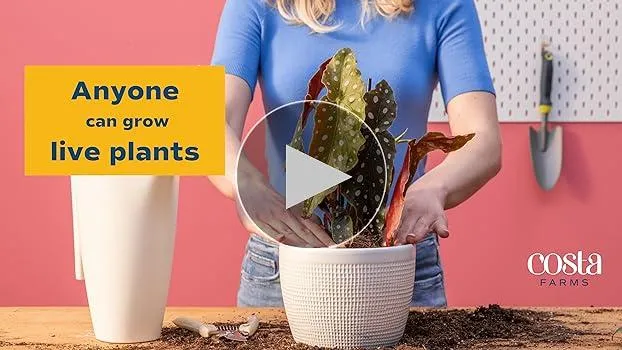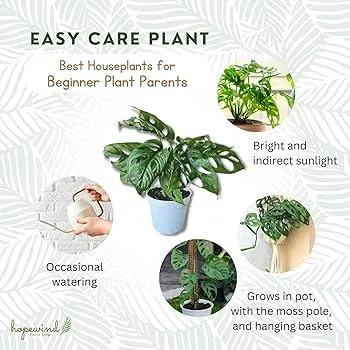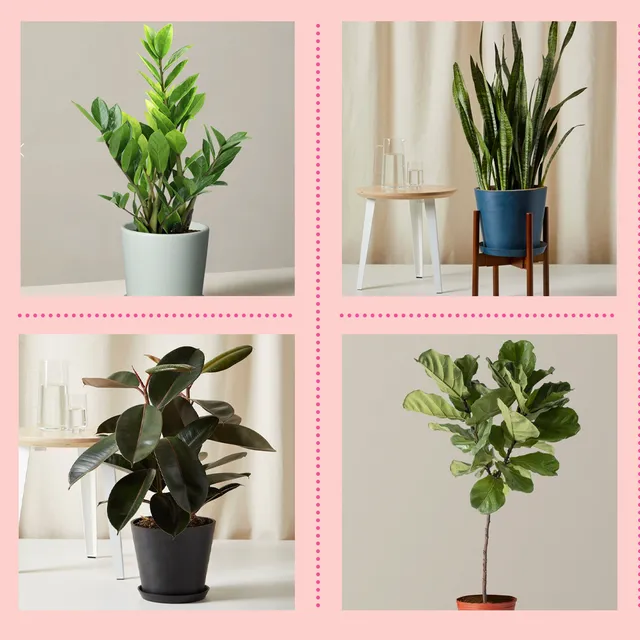
Best Houseplants for Beginners – Easy Care Indoor Plants Anyone Can Grow
Top 10 Easy Houseplants for Beginners
If you’re new to caring for houseplants, starting with low-maintenance varieties is the way to go. Here are 10 plant choices that even black thumbs can keep alive, along with tips for their care.
1. Spider Plant (Chlorophytum comosum)
- Water when topsoil is dry
- Trim off brown shoots and hang cuttings in water to get free plants
- Can tolerate low light but will grow taller in bright indirect light
From my own experience, spider plants are incredibly hardy. I’ve left them dry for too long by mistake but they always bounce back with a little TLC. They also produce small white flowers on their stems in spring. Propagating their plantlets is fun for beginners and results in more plants to gift to friends and family.
2. Pothos (Epipremnum aureum)
- Water when top inch of soil is dry
- Thrives in medium to low light but variegated varieties need slightly more light
- Not fussy about humidity and tolerates low light well
Pothos have long vines that can be trained up poles or trellises for an outdoor jungle look indoors. Thanks to their trailing nature, they’re great for filling out shelves or hanging baskets. I find their hardiness impressive – they don’t seem to care if their soil dries out completely between waterings. Their heart-shaped leaves come in both solid green or variegated forms with splashes of yellow or white.
3. Snake Plant (Sansevieria trifasciata)
- Water every 2-4 weeks when soil is dry
- Thrives in average to low light conditions
- Tolerates neglect well – water infrequently
Snake plants are one of those foolproof houseplants that can survive under less than ideal care. That’s because they store water efficiently in their thick leaves. They also purify indoor air of toxins like formaldehyde. From my experience, snake plants definitely live up to their reputation. I forgot to water one for over a month and it was fine! Their stiff vertical leaves bring nice structured form to your home.
4. ZZ Plant (Zamioculcas zamiifolia)
- Water when topsoil becomes dry
- Thrives in low to medium indoor light conditions
- Tolerates dry air and neglect
The ZZ plant is famous for being nearly impossible to kill. They can go months without watering thanks to their thick succulent-like leaves. I had one on my desk that would be forgotten for weeks at a time and it barely seemed to notice. These plants don’t need bright light either – their handsome waxy leaves complement any interior decor style. Their upright plant form with arching foliage looks stunning all on its own.

5. Chinese Evergreens (Aglaonema)
- Water when top inch of soil dries out
- Prefers medium to low indirect light
- Tolerates low humidity
Chinese evergreens offer beautiful foliage in a rainbow of colors without demanding care. The different cultivars have heart-shaped leaves patterned with shades of pink, cream, white, and green. From my experience, they brighten up any room nicely without being fussy. Their leaves hold up well even if you overlook watering them for a week or so. These plants clean indoor air too by absorbing formaldehyde, making them a win for looks and health.
6. Peace Lily (Spathiphyllum)
- Water when topsoil feels dry
- Prefers medium to low light conditions
- Thrives in humid bathrooms or kitchens
Peace lilies are notorious drama queens – they droop their leaves when they need water as a sign. But despite their theatrics, they’re quite resilient. I once left mine parched and it perked right back up after one good soak. Their glossy deep green leaves and occasional white blooms add beauty to any room. Peace lilies clean indoor air of benzene, trichloroethylene, and formaldehyde too. Their high moisture needs make them well-suited for bathrooms and kitchens.
7. Jade Plant (Crassula ovata)
- Water sparingly when soil is dry
- Thrives in bright light
- Tolerates long periods without water
Jade plants are legendary for being drought tolerant. In fact, it’s easy to underwater them by mistake because they store water so efficiently in their thick succulent leaves. They reward you for inconsistent watering with lovely smooth oval leaves in various colors like bright green, variegated, or reddish tones. These sculptural succulents also hold their own in low light settings when given infrequent drinks. Plus their beautiful waxy leaves shine like gemstones when polished by sunshine.
8. Ponytail Palm (Beaucarnea recurvata)
- Water every 2-4 weeks when soil is dry
- Thrives in indirect conditions but tolerates sun
- Ignore it and it will ignore you!
Ponytail palms are air purifying palm tree lookalikes that are quite interesting houseplants. Despite their name, they’re dracaenas rather than true palms. From my experience, these plants live up to their reputation as low maintenance. I forgot to water mine for a solid month and it shrugged it off like it was no biggie. Their sculptural vertically stacked oval leaves gracefully arch in whimsical ponytail-like bundles, adding architectural presence wherever they’re placed.
9. Dracaena (Dracaena marginata)
- Water every 7-10 days when topsoil dries out
- Thrives in medium to low indirect sunlight
- Tolerates dry indoor air
Dracaenas come in several varieties but the classic marginata type with its broad striped leaves is one of the easiest. They purify indoor air by absorbing toxins like benzene and trichloroethylene. In my experience, dracaenas can take their time drying out between waterings without drooping or wrinkling their leaves. Their vertical lines of foliage add nice architectural structure without demanding much fuss. Stiff upright leaves come in shades of green, white, pink, and red.

10. Lavender (Lavandula angustifolia)
- Water sparingly when soil feels dry
- Prefers full sun but tolerates partial shade
- Let soil dry out between watering
Lavender is a colorful herbaceous perennial ideal for first-time houseplant parents. It boasts aromatic gray-green foliage topped with pretty lavender flower spikes in summer. Thanks to its drought tolerance and preference for gritty soil, lavender is very forgiving when allowed to dry out between watering. From my experience growing it, lavender seems to thrive more on neglect! Its sweet fragrance lifts the spirits whenever you catch a whiff. These cheery plants also attract pollinators with their nectar-filled blooms.
Does this help summarize 10 great starter plants that are resilient enough for beginners? Let me know if you need any clarification or have additional questions! Proper care of these resilient houseplants is fairly basic but consistency is key to keeping them healthy over the long haul.
A good tip is to group plants with similar watering needs together. Place the “infrequent waterers” like snake plants and jade in one area, and “moderate waterers” like pothos and peace lilies in another. Staggered watering helps prevent soggy soil or dried out leaves. You can also get moisture meters to check soil dampness accurately without guessing.
Proper lighting is important too for optimum growth. While many widely tolerate low light, brighter conditions within tolerance boosts leaf size and blooms. West or south facing windows provided the brightest natural light indoors. Rotate pots periodically to prevent leaning.
Repot plants when roots crowd the container; use a pot just 1-2 inches wider. Rinse leaves occasionally when dusty. Provide humidity lovers a pe

Top Houseplants for Beginners
| Plant | Light Needs | Water Needs | Care Level |
|---|---|---|---|
| Pothos | Low to Medium | Let dry slightly between waterings | Very Easy |
| Snake plant | Low | Let dry completely between waterings | Very Easy |
| ZZ plant | Low to Bright Indirect | Let dry slightly between waterings | Very Easy |
| Peace lily | Medium to Bright Indirect | Let dry slightly before watering | Easy |
| Spider plant | Bright Indirect to Direct Sunlight | Let dry slightly between waterings | Very Easy |
FAQ
-
What are some easy houseplants for beginners?
Some good choices for beginners are pothos, snake plant, peace lily, ZZ plant, and spider plant. These plants are basically pretty hard to kill and don’t need a lot of care.
-
How much sunlight do houseplants need?
Most houseplants need at least some light each day to survive. However, too much direct sun can kind of burn their leaves. It depends on the plant – check online or ask an expert at the garden store for guidance on how much light your plant friend specifically enjoys. At the same time, too little light will cause them to become leggy and less healthy looking. Aim to keep them in a spot with bright, indirect light.
-
How often should I water my houseplants?
The frequency of watering depends on the size of the plant and the soil conditions. A good rule of thumb is to check if the top inch or two of soil is dry before watering. Some signs a plant may need a drink are drooping leaves or wrinkled stems. When you do water, be sure to soak the soil thoroughly until water drains freely from the drainage holes. On the other hand, overwatering can cause root rot, so only water when the soil is dry.
-
What kind of potting mix should I use?
Most houseplants do best in a potting mix that drains well but also retains some moisture. A good basic mix contains peat moss or coir for water retention mixed with perlite or vermiculite for drainage. You can purchase premixed houseplant potting soil or make your own. Look for a label that says “houseplant mix” at your local garden center. Nevertheless, the brand doesn’t matter as much as ensuring good drainage through the bottom holes of your planter.
-
How often should I fertilize?
In general, fertilize houseplants only during their main growth period – spring and summer. A weak, balanced houseplant fertilizer works well and can be given every few months when the plant is actively growing. Be cautious not to overdo it, though, as too much fertilizer may burn the roots. Perhaps inspect your plant’s growth and feeding schedule and adjust according to its needs rather than following a strict timeline.

-
Why aren’t my houseplants thriving?
There are several possible reasons a houseplant may not be looking its best. It could just need a drink of water, more light, or fertilizer. Pests like spider mites or mealybugs may be attacking it. The soil could be staying too wet or dry. On the other hand, the plant may have been moved to a sunnier or darker spot than it’s accustomed to. Check conditions and do some research to identify potential issues. With some detective work and adjustment, you can get your plant back on track.
-
What should I do if my houseplant is sick?
If a plant appears wilted, spotty, or infested with insects, there may be an underlying issue to address. Isolate any sick plant from others to avoid spread. Check for signs of over- or underwatering, too much sun or shade, or lack of nutrients. Yellowing leaves may signal pest problems. Treat pests if visible. Prune off severly damaged parts to promote new growth. Consider seeking advice from an expert at your local garden store. With prompt treatment and care, many houseplants can bounce back from mild illnesses.